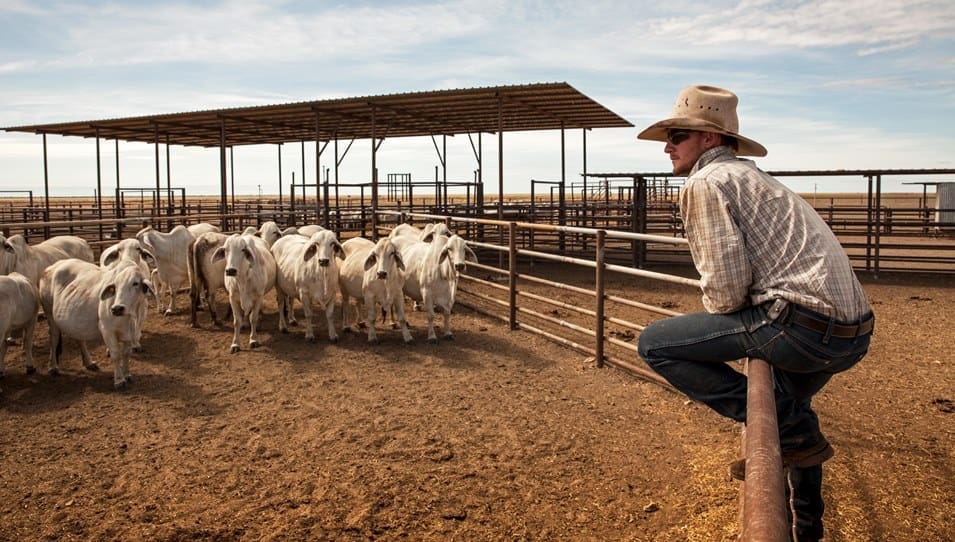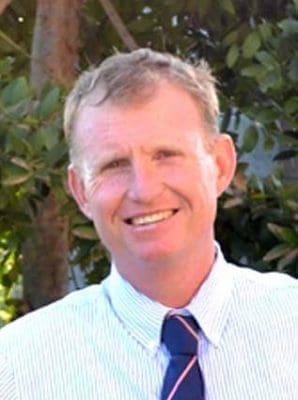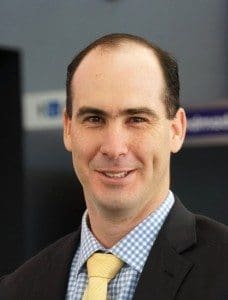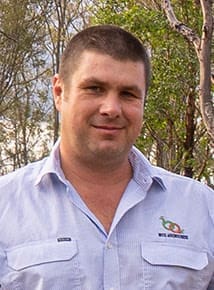
GRAZING property prices are getting beyond the reach of those aspiring to get a start in the Australian beef industry, some industry stakeholders have lamented recently.
This week, three property and investment industry experts give their insight into the difficult challenges facing new entrants.
Martin Pentecost from Biloela-based Grow Agribusiness & Finance said Central Queensland property prices had easily doubled in recent years.
“Figures show that country is now getting close to, or exceeding $20,000 a beast area. For example, a 1600ha holding at Baralaba, running 400 adult equivalents, recently sold for $8 million,” he said.

Martin Pentecost
Mr Pentecost said most entry-level players needed to be working off-farm, because the agricultural enterprise they could currently afford to purchase will not produce enough revenue for them to get by.
As a case study, he referred to a $500,000 finance deal he recently completed for a 24-year-old man who had saved $300,000 over six years.
“He purchased a 176ha block in Queensland’s Banana Shire for around $700,000 or $3977/ha, that can probably only run 40 odd head of cattle. There is no way it can provide a living – it is not a standalone business.”
Mr Pentecost said the young man will have to undertake some fencing and tidy up pastures, but to make the repayments, he needs to keep his $140,000 a year off-farm mining job.
“It will likely take him seven to eight years to pay that debt down to build up enough equity to purchase another small block.”
Mr Pentecost sees a large number of loan applications from younger people who have a very good off-farm income – truck drivers, machinery operators and diesel fitters.
“Post the banking commission, banks have increased focus on loan serviceability. This means it would be difficult for a young jackeroo pulling in $50,000 a year to get going in a property purchase, because they possibly won’t have enough income to service the debt.”
Mr Pentecost said interest rates might be low, but if a buyer needed to find $8 million for a beef operation, a bank would possibly lend up to $5.6m (70pc lend), but the purchaser needed to raise $2.4m plus stamp duty, plus stock.
Without some sort of family succession, properties like that were mostly out of reach.
“The era of entry level players could be drawing to a close, compared to well established, larger farming families who will keep getting bigger,” he said.
Will McLay, Herron Todd White

HTW valuer, Will McLay
Herron Todd White valuer Will McLay agrees the entry level price point has dramatically shifted north.
“If an off-farm wage or income is underpinning the property purchase, what an entry level buyer could afford five years ago and what they can afford now hasn’t changed too much.”
However, Mr McLay explained the entry level price point has changed.
“Dependent on location, a 200 to 400 head grower/finishing operation might be worth $4m to $6m today compared to $1m to $2m five years ago. While the low cost of money and high price of cattle makes the serviceability aspect seem relative, the challenge faced by the entry level buyer is the equity now required to buy the same asset,” he said.
Previously, a resource sector wage and debt free home in a larger regional town might have provided the required ingredients for an entry buyer to secure their first small scale broadacre property.
“However, the positive market shift in rural land values now means this would simply not be possible. Wages and other asset classes have not increased at anywhere near a proportionate rate.”
In relative terms, Mr McLay said the situation hasn’t changed for those who are established in the industry. What has changed is the entry hurdles for those without access to existing rural or generational assets.
Ian McLean, Bush AgriBusiness
 Ian McLean from Toowoomba business management consultancy Bush AgriBusiness said prices being paid for land bear little logical resemblance to the value of those properties based on their earning capacity.
Ian McLean from Toowoomba business management consultancy Bush AgriBusiness said prices being paid for land bear little logical resemblance to the value of those properties based on their earning capacity.
“While it is difficult, the era of entry level players is not over. There are some who will make it work, by holding down multiple jobs while securing smaller blocks and trading up.”
Mr McLean said that every industry faces barriers to entry.
“Financial capital is a barrier to entry into the beef industry due to the value of land and livestock. As a result, a significant amount of capital is needed to get a seat at the table,” he said.
Over time, families and businesses of scale would find it easier to grow and buy up some of the smaller places.
“Some industry consolidation is inevitable, and not necessarily a bad thing. However, the higher prices make it difficult for young people or entry level players to get into the beef industry, meaning they are likely to secure an under-scale enterprise.”
Prices
Ian McLean said while land is a stable investment, it can decrease over time, as seen early last decade.
“Like gold, rural land is a finite resource, it is valuable and low yielding. However, from a purely economic view, particularly when borrowing, a potential buyer still needs to make enough money to make it a worthwhile investment.”
He cited US financial guru Warren Buffett (one of the greatest minds on valuing assets and managing capital), saying the following two quotes are apt for the current land market:
‘Be fearful when others are greedy and greedy when others are fearful’,
and
‘It is only when the tide goes out that you learn who has been swimming naked’.
The sums may look good with record high cattle prices and record low interest rates, but Mr McLean said he could not predict what will happen to either in the short term.
“Buying a property is a long-term venture. Basing sums on cattle prices staying at record highs and interest rates at record lows for the next 20 years could leave a buyer exposed when the tide eventually goes out,” he said.
HTW’s Will McLay believes the current property prices are sustainable if the key metrics (interest rates and cattle prices) don’t vary too much.
“In many respects, land prices are more sustainable now than the last time the market peaked in 2007/08. In that era, the nexus between what a property cost you in interest to own it and its earning capacity meant you were generally worse off just for the pleasure of owning it.”
Mr McLay said money is so cheap today that a producer can buy a place, and in most cases the operating activities of the property will cover the interest on it.
“Rural acquisitions have always been low-yielding enterprises. People don’t generally buy properties for cash-flow, they buy them for a long-term hold to gain the benefit of future capital growth.”
He said the market will always push on and the appetite to purchase will always be there as long as the new buyer isn’t significantly worse off for owning the asset from a cash flow point of view.
“I don’t think that there will be any great level of buy-side market resistance until the holding costs of a rural asset is substantially higher than its earning ability, and in my view, we are not at that point yet.”
In terms of the high property prices, Martin Pentecost said it was a free market.
“It is all about supply and demand. Some producers are willing to pay the high prices, but if you are a young person trying to get a head start, it is tough.”
“Who knows when the property market is going to drop? No one can tell and it is the same with interest rates. Yes, they are low, but banks claim they will not drop any lower than present levels,” he said.
Mr Pentecost said producers needed to buckle themselves in for a ride.
“When interest rates do rise, some bankers are of the opinion they will rise several points relatively quickly. Several accountants believe a rise from 2.5pc to 5pc (a doubling of interest rates) would be equal to levels reached the 1980s (18pc to 19pc) simply because people are so heavily geared.”
Would he be fearful of buying into the current market?
“Absolutely. There is a reason why I believe some of the more recent corporate players who have purchased large-scale operations in the past five to seven years are selling their northern Australian assets – there’s no such thing as a bad profit.”
Mr Pentecost said the property market today was ‘just so hot.’
“Many producers say they can’t make the sums add up and I agree, some producers may just get burnt buying in the current market.”
Advice to entry level players
Bush AgriBusiness’s Ian McLean encouraged entry level players to look for alternative pathways in the industry beyond land ownership.
“Becoming a professional manager can provide a financial and professionally rewarding career and may lead to a better retirement. I am not talking down the dream of owning a property, but it may be a better outcome.”
Martin Pentecost agrees, saying there are always other ways to skin a cat.
- Young people could consider a residential investment. Purchase a house in town for $500,000 with an 80pc lending capacity as opposed to a rural block at a 7pc lend, concentrate on reducing that debt and use that as equity for the next step.
- Leasing is an opportunity if they can find country – lease and agistment is currently a red-hot market.
- Consider purchasing elsewhere.
Further reading:
https://www.beefcentral.com/property/beef-land-versus-gold-which-is-the-better-investment/



The case study by Mr Prendecost is interesting.
This young man is buying 179 Ha for $700,000.
He would pay that amount for a nice home in the city.
Smart lifestyle decision.